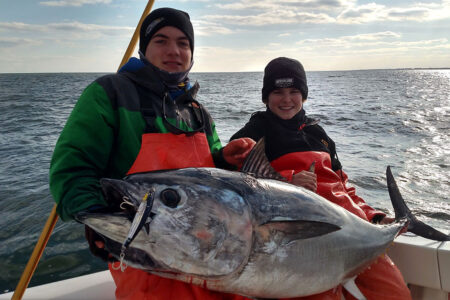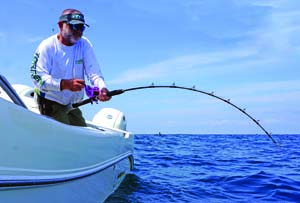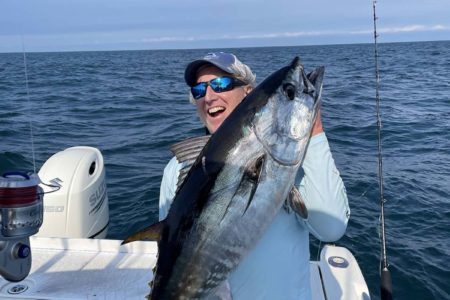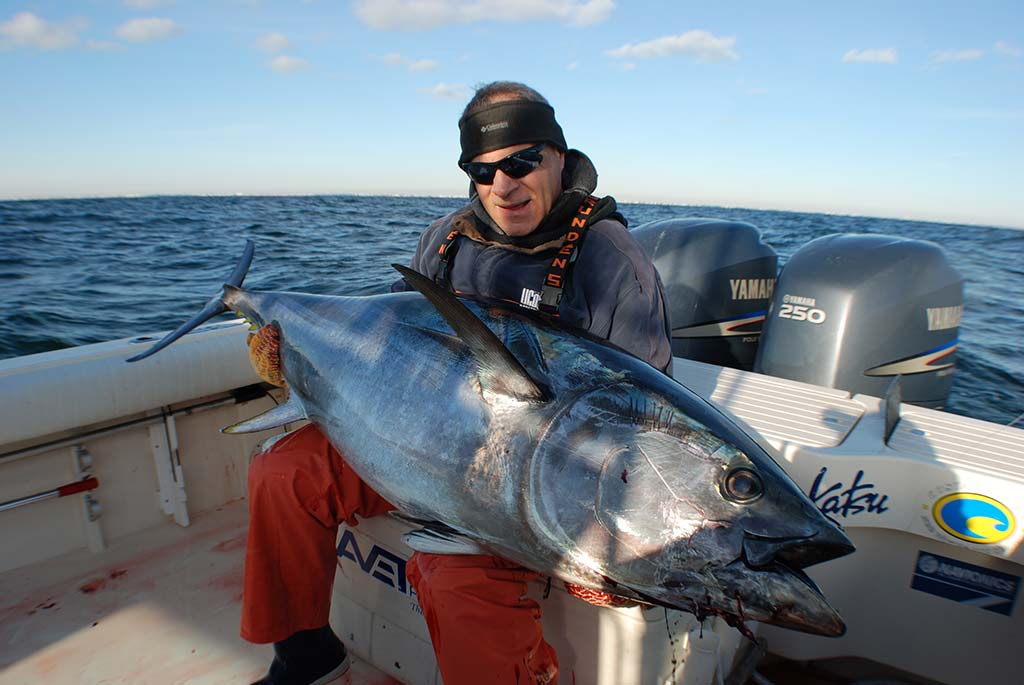
While trophy giants of 73 inches and up are limits, we’re still just scratching the surface on this year’s bluefin run.
If you want a December to remember, then chasing bluefin up top should be part of your game plan as this season comes to a close. During this month, we normally see a southerly migration of 80- to 250-pound bluefin moving down from New England on their way to the spawning grounds in the Gulf of Mexico. These bluefin will take a route that is only 3 to 15 miles from the beach if the bait is present that they need to feed on. Sand eels, sea herring, sauries, and squid are the choice morsels that will fuel up these bluefin. When these baits show up inshore, then expect the bluefin to be on them too.
In the circles that I travel, the Atlantic bluefin tuna is without a doubt, the most prized catch for anglers. This is a magnificent fish in both appearance and fighting ability. To the untested, this fish will amaze and exhaust you with its speed, power, and endurance, especially when catching them with topwater poppers and stickbaits. Throughout the season, I am always ready to cast at bluefin when they show themselves but it is a topwater catch during December that will truly make your claim to fame.
A catch on top now means a lot more than in the summertime as this is serious business, cold, and hardcore. Since the water is much colder than in the summer, the bluefin will retain their stamina much longer before they tire out and go into their death spiral. This means a much longer fight, and a hundred-plus pound tuna can have you passing the rod off before it hits the deck. Add to this that bluefin are also much more finicky now and will pop up here and there only to sound quickly as your boat approaches. For this reason, tuna junkies have dubbed the phrase “chasing ghosts” when going after them in December.
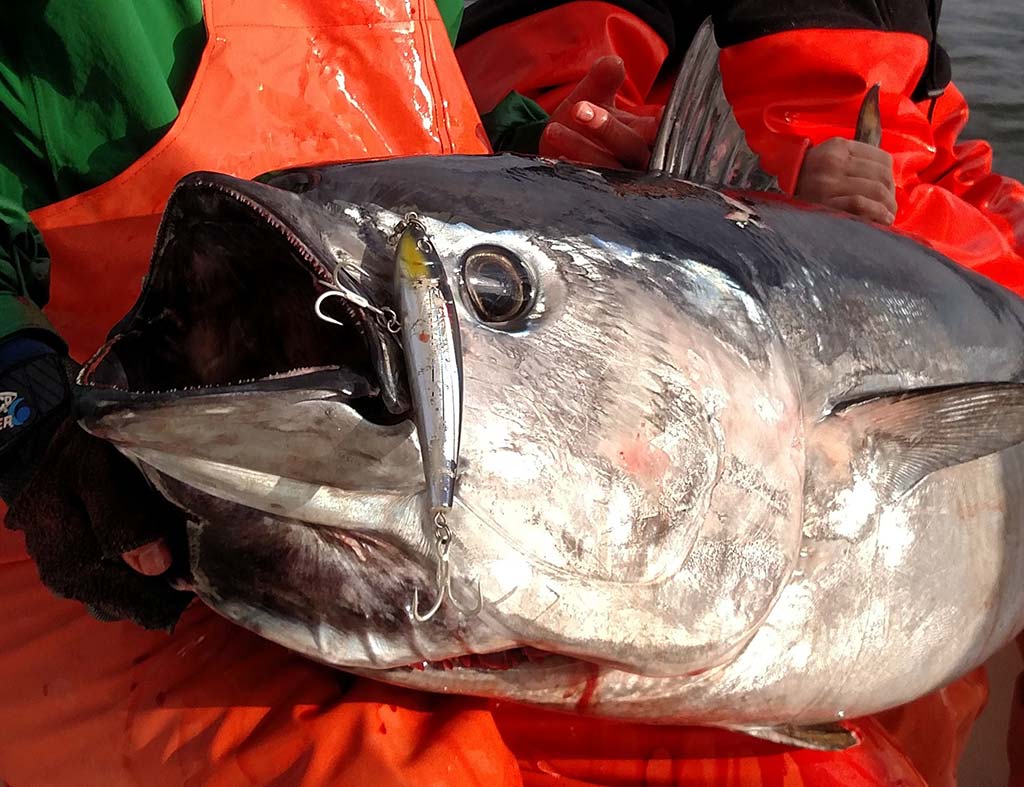
The Search Begins
One of your keys to success is that you will need to put your time in and drive around to score a win. By going out once or twice during this month and heading to one particular location expecting to have shots at fish is highly unlikely that you will see bluefin and connect. Instead, the most successful ghost hunters are those that are willing to put in their time, burn a lot of fuel, and go looking to find the bluefin. The other factor that will come into play this month is weather. Getting a safe weather window may not happen on the weekend when you are able to go. So those that are most flexible and can go at any time will have the best opportunity to score.
It is best to have a float plan when you head out as to where you will be searching and when you will return to port and leave this with someone back at your home port. It is a must that you have all your safety gear in place and communications in order. A Garmin InReach is also a good idea as it will allow you to text anyone via satellite if you need to if you are out of cell range. A mechanical breakdown at this time of year can be life threatening, and getting help as quickly as possible is a must.
As to where to look for the bluefin, I would base this off the most recent intel that you can get as to where the tuna have been. If you have intel from the day before, head in that direction first. As you are heading in this direction, use a good pair of stabilizing binoculars to look for birds such as gulls, terns, shearwaters, or tuna chicks that may be hovering just about the surface of the water as they move along. You will not see your Hitchcock-style bird action as we see in the late fall when targeting striped bass but instead, you may see only one to several birds. These birds will pinpoint the bluefin below as they are eyeballing them just below the surface.
Also, look for any marine life such as whales that are feeding as these are more than likely to have bluefin with them. This is so because an established food chain will be present in the area where the whales are feeding. Whales are massive creatures and require a lot of food to sustain them. If they are diving, surfacing, and circling, this is a sure sign they are feeding; same for porpoises, and if they are exhibiting the same behavior, they too are feeding. Stop and cast.
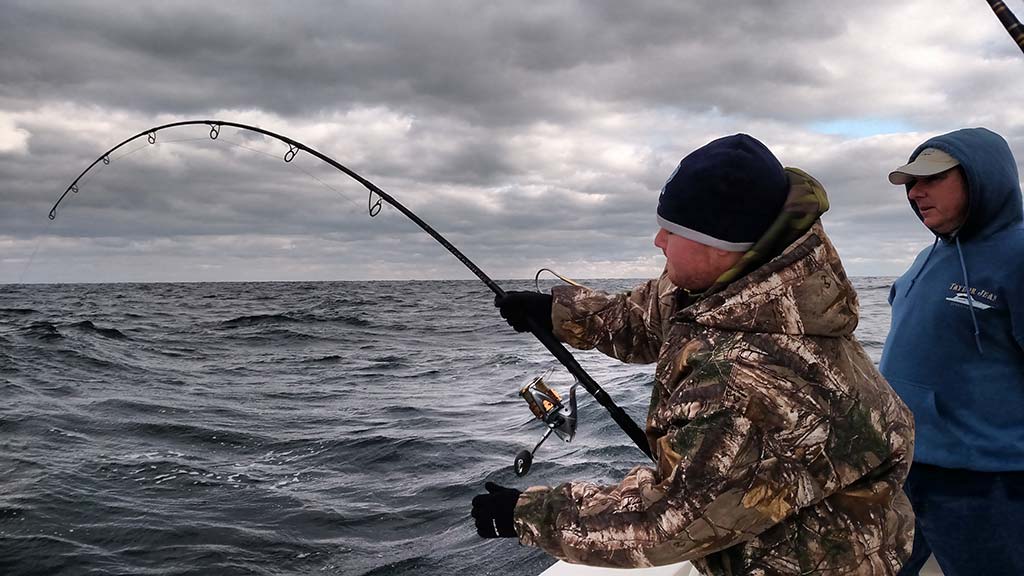
Breezer Gear
You may not always see bluefin busting on the surface but rather they will also exhibit a behavior where they are cruising just below the surface, quivering from side to side. Here you will see a subtle wake on the surface, and with a good pair of polarized sunglasses, you will see their iridescent colors shimmering just below the waterline. We call these tunas “breezers.”
When you approach busting fish or breezers, it is the throttle man that is hugely responsible for the success you will have. One must watch the pod of tuna to see which way they are moving and then position the boat ahead of them within a long cast range. It is important when you make your cast that your lure lands in front of the bluefin and then is pulled away from the tuna so it mimics what would really happen in the wild. A tuna chasing down a bait. Pulling the artificial towards a pod of bluefin or across their path is not as realistic or effective.
The rod and reel of choice when casting poppers or stickbaits is a specialized 7-foot, 8-inch to 8-foot, 2-inch spinning rod like the 7-foot, 9-inch Centaur Chiron Inshore Game or the Nomad 7-foot, 8-inch PE 8-10 popping rod. These are spooled with 80-pound braid and 80- to 100-pound fluorocarbon leaders with a 14K Shimano Twin Power as my reel of choice. The Van Staal 250 or Shimano Stella 14K is also ideal.
I like to use a BHP Tackle pre-made casting leader that has a loop in the end. This is looped-looped to my braid. This connection should not sit around the reel when you are ready to cast or it will cut down on your distance. It should be just off the reel below the first guide. For this reason, I will cut down the pre-made BHP 12-foot leaders to about 8 feet.
The popper retrieve that is most effective is also different than a striper retrieve. Rather than retrieving in a steady motion, the retrieve is several pops or chugs and then a long pause. The pause is what triggers the aggression strike from the tuna as it goes in for the kill on what appears to be an injured bait. The retrieve is also slow. My most productive poppers are the M. Fischer, Nomad Chug Norris, and the new XL Madd Mantis.
The retrieve for a stickbait is a long sweep also followed by a pause. The stickbait is not a steady striper type of retrieve. For stickbaits, use sinking types because you want them to be able to dig just below the chop. My favorites are Nomad Design Madscad Holo Ghost, Smith Baby Runboh, Tailwalk Gunz, and the Shimano Coltsniper, a tuna grade lipped swimmer that is easier to work than a lipless stickbait.
In order to fish for, take, retain or possess bluefin tuna and other highly migratory species (HMS), the owner/operator of a recreational vessel must have the appropriate valid permit onboard which you can get at hmspermits.noaa.gov.
Casting 8- to 10-inch Bill Hurley and Ron Z type artificials fished on 1- to 4-ounce jigheads are also very effective at this time of year because you can get them to sink deep into the water column and cover a lot of water vertically if the bluefin are not responding up top. If sand eels are the main forage in the area, then casting these artificials will serve you well. These can be fished in a variety of ways, as I have caught bluefin using many different types of retrieves. A slow twitch, erratic jig, or ripping it through the water have all worked.
